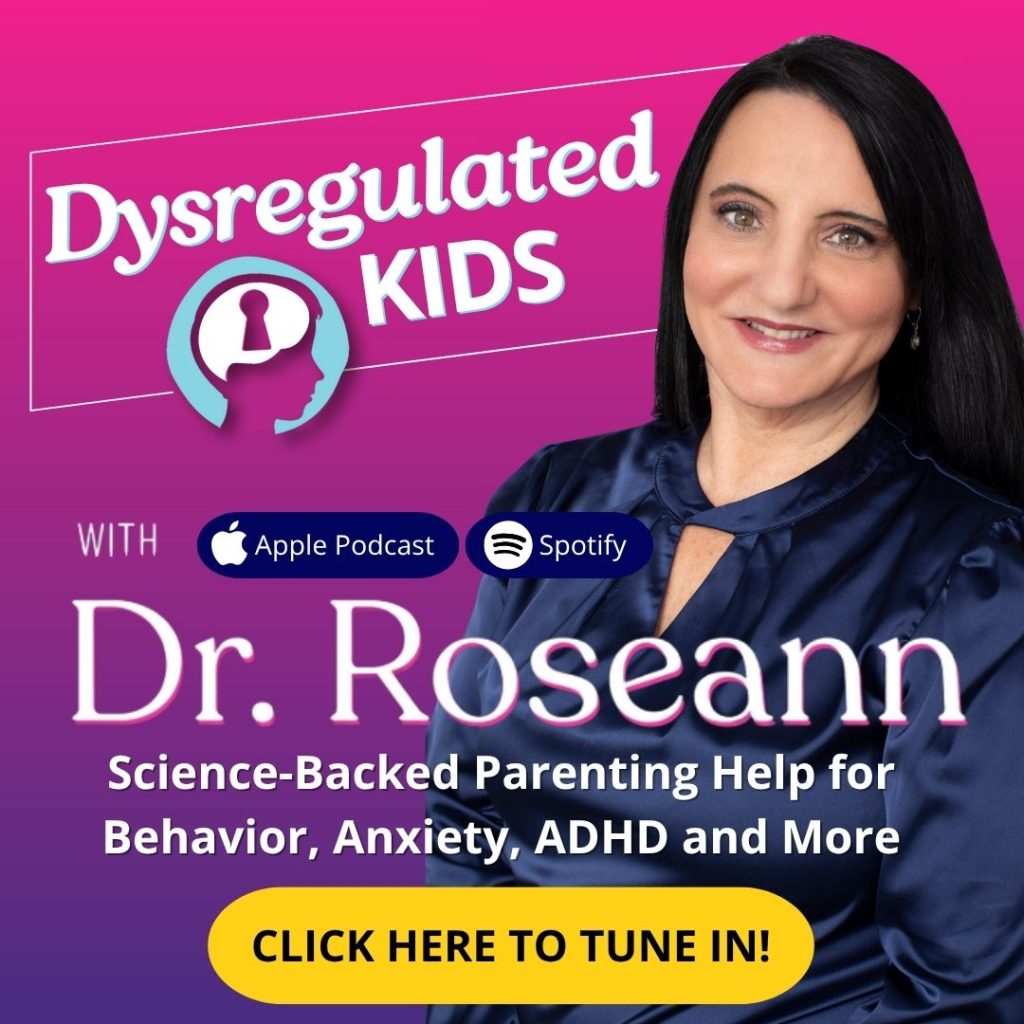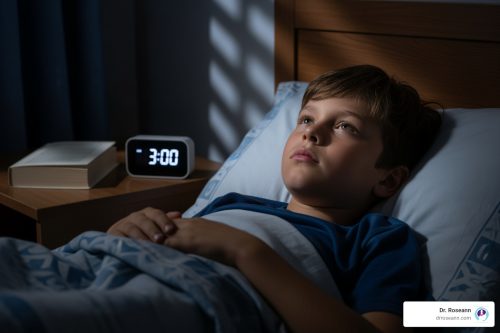Estimated reading time: 7 minutes
Too many reminders, meltdowns, and missing homework? Here’s how to calm the brain and build executive skills—without shame or power struggles.
If your child’s behavior feels out of control lately, you’re not alone. In my clinic, I meet loving parents every day. They are exhausted by disorganization, emotional outbursts, and struggles at school.
The good news: executive function can be taught. And when we calm the brain first, kids think, plan, and cope better.
In this guide, I’ll show you science-backed, parent-friendly ways to improve focus and organization. And I’ll also discuss self-regulation using mindfulness and routine tweaks that fit real family life.
You’ll learn:
- What executive functioning is
- How stress and dysregulation block it
- Simple mindfulness habits that work
- Practical tools for home and school—plus when to get extra support.
What Are Executive Functioning Skills—And Why Do They Matter?
Executive functions are the brain’s “air traffic control”, responsible for:
- Planning
- Working memory
- Task initiation
- Time management
- Emotional self-control
- and Flexible thinking.
When these skills lag, everyday life gets hard. Morning routines get derailed, and minor frustrations trigger significant reactions.

How Does Stress and Nervous System Dysregulation Impact Executive Function?
Stress flips the brain into fight–flight–freeze. It pulls resources away from the prefrontal cortex (where EF lives).
Research shows that on high-stress days, performance on attention-demanding tasks drops (Sliwinski et al., 2006). When the body is dysregulated, reasoning and organization go “offline.”
How Can Mindfulness Actually Help Kids’ Executive Skills (Science-Backed)?
Mindfulness is a simple practice of paying attention on purpose, in the present moment, non-judgmentally. It reduces stress and improves attention.
In elementary students, brief school-based mindful awareness practices improved executive function in just eight weeks (Flook et al., 2010).
In families of children with autism, parent-mediated mindfulness programs reduced anxiety and problem behaviors, improving daily life (Hwang et al., 2015).
What Quick Mindfulness Strategies Work for Busy Families?
These 1–3 minute practices regulate the nervous system and boost attention:
- Box Breathing (4-4-4-4)
Inhale 4, hold 4, exhale 4, hold 4. Do 4 rounds. Great before homework or bedtime.
- Body Scan (head to toe)
Notice and relax each body area. Builds interoception and inhibitory control.
- 5–4–3–2–1 Grounding
Name 5 things you see; 4 touch; 3 hear; 2 smell; 1 taste. Resets meltdowns quickly.
- Mindful Listening
Eyes closed, count 3 sounds. Trains selective attention; perfect classroom prep.
- Guided Visualization
Picture each step of an upcoming task (packing backpack). Pre-loads working memory.
Jon Kabat-Zinn defines mindfulness as “paying attention in a particular way: on purpose, in the present moment, and nonjudgmentally.”
How Do I Help My Child Start and Finish Tasks Without Constant Reminders?
Instead of nagging, think of scaffolds that calm the brain and make tasks feel doable.
Make Starting Gentle
- Try the two-minute rule: “Just start for two minutes.” Small wins build momentum.
- Use body doubling: sit nearby as your child begins—the calm presence helps regulate focus.
Make Finishing Realistic
- Break tasks into short blocks with mindful pauses.
- Externalize time with visual timers or checklists so the brain isn’t overloaded.
- Cue transitions calmly: “In five minutes, Legos pause and shoes go on.”
| Situation | Nagging (don’t use) | Scaffolding (use this) |
|---|---|---|
| Morning routine | “How many times do I have to tell you? Get dressed!” | “Let’s breathe once, then check the morning card—what’s first?” |
| Starting homework | “If you’d just start, you’d be done by now.” | “We’ll start for two minutes together. I’ll sit with you—then you take the lead.” |
| Transition off screens | “Turn it off NOW. I’m serious!” | “Timer’s done—pause game. Want a movement break or water first?” |
| Cleaning up | “This room is a disaster. Clean it properly!” | “Pick three things to put away. I’ll do three too—ready, go.” |
| Leaving the house | “We’re late because of you—hurry up!” | “Shoes, water, backpack. Want me to read the checklist while you grab them?” |
| Forgetting materials | “You’re so irresponsible. You always forget.” | “Backpack check: folder, planner, pencil pouch—touch each as you say it.” |
| Interrupting | “Stop talking over me!” | “I want to hear you. Hand on my arm = your turn next. I’ll finish this sentence.” |
| Meltdown brewing | “Calm down right now.” | “I’m calm and here. Let’s do 5-4-3-2-1 together; then we’ll solve it.” |
| Slow work pace | “You’re being lazy.” | “Let’s set a 10-minute timer for just this part, then a short stretch.” |
| Avoiding a tough task | “Quit making excuses.” | “Which feels easier to do first: the title or the first sentence? You choose.” |
What Routines and Tools Can Make School and Homework Less Stressful?
Think calm structure, not pressure. Simple rituals and mindful tools ease the load on a busy brain.
Create Calming Routines
- Use picture cards for morning and after-school flow.
- Start homework with a short ritual: move, sip water, and practice a calming breath.
- Do a quick daily backpack and planner check—same time each day builds predictability.
Use Mindful Tools
- Visual schedules or first–then boards reduce overwhelm.
- Color-coded folders with to-do/done pockets give the brain a sense of completion.
- Movement snacks—short bursts of activity—refresh focus.
Collaborate With School
- Request simple supports, such as chunked deadlines, visual rubrics, and movement breaks.
- Share what calms your child so teachers can co-regulate, too.
Keep the Calm Going: Your Quick Next Steps
We covered how to help with executive functioning skills by calming the brain first. Then layering simple mindfulness habits, scaffolds, and routines so kids can think clearly, start tasks, and finish strong. You’re doing better than you think, and with steady practice, it will get easier.
Keep going. Download now my Executive Functioning Parent Toolkit and use it today.
FAQs
How long until we see progress?
Tiny wins can show up in a week (fewer prompts, calmer transitions) when you practice daily—especially breathing + routines. Bigger gains build over months through repetition (Flook et al., 2010).
Is mindfulness a replacement for ADHD treatment?
No. It’s a foundation. Mindfulness and routines enhance attention, working memory, and emotion regulation and can make other treatments (including medication, CBT, neurofeedback) work better (Hwang et al., 2015).
My child melts down—tantrum or “red zone” dysregulation?
Meltdowns are nervous-system overload, not willful misbehavior. Ground first (5-4-3-2-1), then connect, then teach when calm.
What about neurofeedback or cognitive training?
Neurofeedback and structured cognitive training (e.g., working memory programs) can help some kids—after daily regulation and routines are in place. Always choose reputable providers and track outcomes.
Citations
look, L., Smalley, S. L., Kitil, M. J., Galla, B. M., Kaiser-Greenland, S., Locke, J., Ishijima, E., & Kasari, C. (2010). Effects of mindful awareness practices on executive functions in elementary school children. Journal of Applied School Psychology, 26(1), 70–95. https://doi.org/10.1080/15377900903379125
Hwang, Y.-S., Kearney, P., Klieve, H., Lang, W., & Roberts, J. (2015). Cultivating Mind: Mindfulness interventions for children with autism spectrum disorder and problem behaviours, and their mothers. Journal of Child and Family Studies, 24(10), 1–14. https://link.springer.com/article/10.1007/s10826-015-0114-x SpringerLink
Sliwinski, M. J., Smyth, J. M., Hofer, S. M., & Stawski, R. S. (2006). Intraindividual coupling of daily stress and cognition. Psychology and Aging, 21(3), 545–557. https://doi.org/10.1037/0882-7974.21.3.545 Europe PMC
Always remember… “Calm Brain, Happy Family™”
Disclaimer: This article is not intended to give health advice, and it is recommended to consult with a physician before beginning any new wellness regimen. The effectiveness of diagnosis and treatment varies by patient and condition. Dr. Roseann Capanna-Hodge, LLC, does not guarantee specific results.
Are you looking for SOLUTIONS for your struggling child or teen?
Dr. Roseann and her team are all about science-backed solutions, so you are in the right place!
©Roseann Capanna-Hodge










